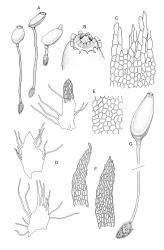Plants mostly solitary, arising from inconspicuous protonemata. Leaves numerous at base of setae, mostly 600–750 µm, lanceolate, weakly toothed or crenulate at margins. Mid laminal cells variable in size, 27–66 × 12–15 µm.
Setae red, c. 13–24 mm, to c. 350 µm diam., smooth, surrounded at base by numerous persistent leaves; capsules 6–9 mm (including neck), nearly erect, green at maturity, narrowly obovate, convex on all surfaces and lacking a border between the upper and lower surfaces, tapered to a narrow, ± transverse, and clearly delimited mouth (not surrounded by flaps of exfoliating exothecial cells), with a small and weakly swollen neck; exothecial cells irregular in outline, firm-walled, not exfoliating; stomata superficial, 2-celled; operculum c. 0.8–1.0 mm high, rounded at apex. Exostome teeth scarcely exceeding the mouth; endostome sometimes fragmenting to form numerous parallel filaments. Spores 9.5–12 µm, finely papillose.
NI: N Auckland, including offshore islands (GB), S Auckland (Pārāwera, Rotorua-Taupō-Kaingaroa area, Pongakawa), Gisborne (Te Wera Reserve), Hawke’s Bay (Wairoa), Wellington (Te Maire Scenic Reserve, Whanganui River, Francis Stream); SI: Nelson (Abel Tasman N.P.), Westland (Barrytown).
Endemic or possibly Australasian.
Growing mostly on shaded rock (greywacke, granite, volcanics, or papa) or occasionally on gravel, in open or forest situations. Mostly as isolated plants in mixed bryophyte mats. On NI from c. 50 to 610 m; on SI known only from 2–3 collections from below c. 250 m.
The exostome in this species is extremely short and difficult to observe; like Sainsbury (1955, p. 27), I am unable to confirm the number of rows of exostome teeth present. I have, however, had little difficulty (unlike Sainsbury 1955, p. 27) determining that the stomata in N.Z. material are superficial. Both these features were used by Brotherus (1925, p. 488) to define intrageneric taxa in Buxbaumia.
Stone (1983) compared the N.S.W. type of B. coleryae to two specimens of B. novae-zelandiae. She reached the tentative conclusion that B. coleryae should be recognised as distinct, largely on characters of the operculum (form of the apex, cell size, and overall size) and a slight difference in the degree of immersion of the stomata. The type material of B. coleryae has not been seen but, considering the variability of B. novae-zelandiae, the distinguishing features that she cited are unconvincing, e.g., the opercula in N.Z. range from 0.8 to 1.0 mm and are generally rounded apically. I have found the mid operculum cell dimensions in N.Z. material to agree with Stone’s measurements, but doubt that these differences, and her observations on the stomata, are sufficient reason to retain the Australian species as distinct. Phytogeographically, too, it seems likely that B. coleryae, recorded from N.S.W. and Qld, is conspecific with the N.Z. species.
Stone (1983) also discussed and illustrated the morphology of the foot region of B. novae-zelandiae in considerable detail.
The holotype of Buxbaumia tasmanica Mitt. is a single capsule (NY-Mitten!) collected by Archer from Cheshunt, Tasmania. Buxbaumia novae-zelandiae has entirely smooth setae whereas the seta of Mitten’s type has obscure papillae. Stone (1983, p. 548) apparently did not see type material and she (quoting Mitten 1859 and Dixon 1929) downplayed the papillae, despite their being visible under the stereoscope. The seta in Mitten’s type is 8.5 mm and the capsule (exclusive of the conic operculum) is 6 mm long. I have been unable to see leaves in Mitten’s type, which he described as sparsely ciliate ("foliis parvis ciliatis"). I agree with Dixon (1929, p. 369) that B. tasmanica is not conspecific with B. novae-zelandiae.






